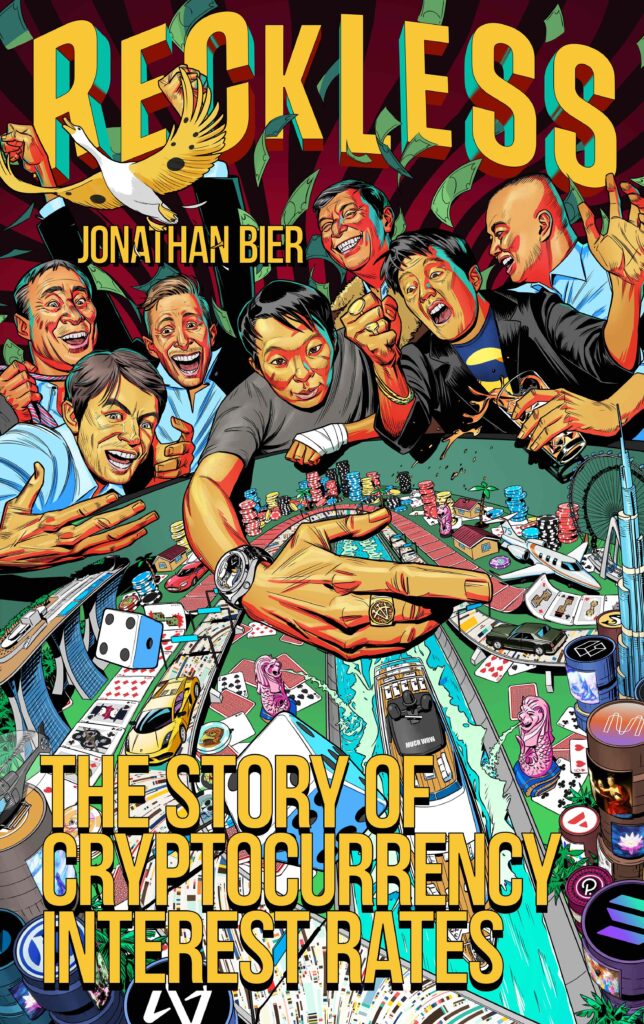Chapter 7 of the book Reckless: The Story Of Cryptocurrency Interest Rates is published below. The full book is available on Amazon. The book was written before the bankruptcy of FTX and therefore does not include coverage of this event. However, the book does provide useful commentary in the run up to the failure of FTX, which provides context for the eventual calamity.

For the first three or so years of Bitcoin, there was not much in the way of interest rates, yield or opportunities to earn a passive income. In 2011 there were a few Bitcoin mining related investment schemes, many of which turned out to be scams. Many of these schemes took place on the Global Bitcoin Stock Exchange (GBLSE), an early Bitcoin based stock exchange platform. For example, in May 2012 some mining contracts on GBLSE offered an annual rate of return of 106%. There were also non-mining investment opportunities, such as TYGRR_BANK, which promised an annual rate of return of 211%. None of these schemes reached a scale that is particularly noticeable, except one, one of the highest returning savings schemes, the “Bitcoin Savings & Trust” product.
Bitcoin Savings & Trust
Bitcoin Savings & Trust launched in November 2011 and was perhaps the first example of a Bitcoin interest rate, at least related to a product that attracted a significant amount of capital. Trendon Shavers (AKA Pirate40) pseudonymously operated a ponzi scheme where he promised a return of 1% per day if you sent him Bitcoin. This is an annualised rate of 3,678%. The available interest increased the more one deposited. 4.2% a week for under 100 Bitcoin, 5.6% a week for up to 500 Bitcoin and then 7% a week for over 2,000 Bitcoin. The investment scheme was said to be engaged in several trading strategies: i. Lending Bitcoin to third party network members, ii, Bitcoin arbitrage trading strategies on exchanges and iii. OTC transactions. Pirate40 is said to have claimed these activities, which were proprietary and secret, produced a yield of 10.65% per week and as such his yields were sustainable and covered by the profits. At its peak over 500,000 Bitcoin were deposited into the scheme, worth around US$7 million at the time.
It is not clear whether the scheme was always a ponzi scheme. Trendon appears to have acted as an intermediary, taking client deposits and then loaning them out, possibly to traders on the largest Bitcoin exchange at the time, MtGox. These debts are likely to have gone bad resulting in insolvency. Pirate40 blamed one large debtor for this. It is also possible that Pirate40 was not directly operating a ponzi scheme himself, he could have been passing client funds over to a third party, who was operating a ponzi scheme. While this may not be exactly what happened in 2022, this structure may share some characteristics with the cryptocurrency deposit taking institutions of 2022, who may have had too much exposure to large leveraged funds such as Three Arrows Capital (3AC). Anyway, at some point in 2012, Bitcoin Savings and Trust, converted from a lending operation to a ponzi scheme, where old investors were paid out with new client deposits.
On 17 August 2012, the Bitcoin Savings & Trust scheme was finally shut down and closed for new deposits. As a result, the price of Bitcoin crashed, from around US$15 a coin to US$10. Before rallying again and stabilising at around US$12. Pirate40 explained his decision to close the scheme as follows:
As the fund grew there were larger and larger coin movements which put strain on my reserve accounts and ultimately caused delays on [withdrawals] and the inability to fund orders within my system. On the 14th I made a final attempt to relieve pressure off the system by reducing the rates I offered for deposits. In a perfect world this would allow me to hold more coins in reserve outside the system, but instead it only exponentially increased the amount of withdrawals overnight causing mass panic from many of my lenders.
Despite the closure, Pirate40 still maintained at this point that all depositors would get their money back, plus interest. However, many in the community did not believe the deposits would be returned. For example, Bitcoin developer Gregory Maxwell sarcastically said to Pirate40 over IRC “since everyone assumes you’re going to vanish with all the coins; why not do so?”
As it turns out, the scheme was a classic ponzi scheme and depositors did not get all their money back. Approximately 48 of the 100 investors lost all of their money. Mr Shavers was eventually arrested in 2014 and pleaded guilty in 2015. Then in 2016 he was sentenced by a judge in Manhattan to 18 months in prison for securities fraud.
On 30 August 2012, Mr Shavers ironically lost a 5,000 Bitcoin bet against a critic of his service, the bet was over whether Bitcoin Savings and Trust was a ponzi scheme or not. Each party sent 5,000 Bitcoin to a third-party escrow agent. On 30 August 2012 the escrow agent said:
I hereby declare the bet decided, [against] Pirate40. A withdrawal request made on August 15 2012, is still outstanding as of today, which triggers default.
